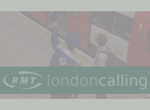The underground railway (Metro) in Finland's capital city Helsinki is due to go 'driverless' in 2016. I discussed this with Finnish trade unionists Jussi and Satu, and heard a story that has important lessons for London Underground workers and passengers trying to prevent the same calamity happening in London.
The proposal to introduce driverless operation on the Helsinki Metro was first raised in 2007. The trade unions opposed it (note that as city council employees, the Metro workers are members of the public sector trade union rather than a transport union).
In 2009, the proposal was shelved, as it was considered to be technically impractical. Believing the issue to be off the agenda, the unions stopped their campaign. With hindsight, they now regret doing so, as the plan for driverless trains returned in 2012 - and this time, the authorities are determined to go ahead.
The Helsinki Metro is owned and run by the city council. Twice the council voted against driverless trains, but the proposers kept pressing the plan until they got the result they wanted: on the third occasion, the vote was passed.
It was supported by the Mayor, and by the the largest party on the council - the National Coalition, similar to our Conservative Party - and the second largest, the Greens. Members of the third largest party, the Social Democrats, opposed the proposal. (As an aside, the parties have similar levels of representation in the national government. The Transport Minister is a Green Party member, and is privatising state-owned transport companies.)
At first, public opinion opposed the introduction of driverless trains, for the obvious reason that it would endanger passengers' safety. But the city council ran a massive media campaign extolling its virtues. The campaign emphasises that it would lead to a train-every-two-minutes service, a doubling from the current train-every-four-minutes service. Of course, many metros already run services at least this frequent while retaining drivers, including some London Underground lines. But following the council's concerted campaign, public opinion now supports driverless operation.
The driverless trains are being supplied by Siemens. They were originally going to cost 70m euros, but this price went up to 150m euros, and is now around 210m euros. This is, of course, public money going to a private company. The council is trying to get some of this money refunded by Siemens, but the trade unions do not think it will succeed.
Having been wrong footed by the reappearance of the proposal and the successful publicity campaign, the union now feels powerless to prevent the removal of drivers, which will take place in 2016 when the Metro line is extended. The union is reduced to negotiating over the terms on which it will be done.
The council has already promised alternative employment to displaced drivers, although many do not want it. The union is demanding that drivers redeployed into other jobs keep their driver's rate of pay, but the council is resisting this - and has even made new drivers who started from 2012 sign contracts that they accept that their pay rate will not be guaranteed when their driving job is scrapped.
The Helsinki Metro is much smaller, and newer, than London Underground. There are just 83 Metro drivers. They will be replaced on the trains by guards. However, the guards will be paid 2,200 euros per month, whereas drivers are paid 2,800-3,000 euros per month. Moreover, there is a genuine fear that the guards are only there to reassure the public, and that in a few years' time, when passengers are used to driverless trains, the guards too will be scrapped.
Ironically, the 83 drivers are being replaced by 130 guards, as guards need to double-up in many situations for their own safety. So while this move creates jobs in the short term, they are lower-paid jobs, and in the medium term, jobs will be cut.
Meanwhile, on Finland's mainline railway, each train has a driver and two conductors. However, the government - ever keen to cut costs and cut jobs - is suggesting that there are not enough problems or bad behaviour on trains to justify two conductors, so want to cut it to one. Perhaps it has not crossed the government's mind that the reason there are not too many problems is precisely because there are two conductors, and that therefore scrapping the second one is inviting trouble. Or perhaps it did occur to the government but it didn't care.
Lessons for London Underground workers? I would suggest:
- know who our reliable political allies are (and who they are not)
- keep our campaign going even if the authorities appear to give up or back down
- do not rely on the technical difficulties of driverless operation to prevent it coming in
- just because public opinion is against it now, beware that this can change - keep fighting for public support for our view
- staffed trains are not an acceptable alternative to drivers on trains
- we must stick to our guns in opposing driverless trains, not retreat to negotiating the terms of their introduction
- Janine's blog
- 11219 reads





